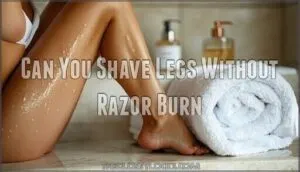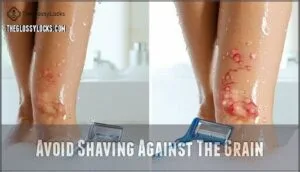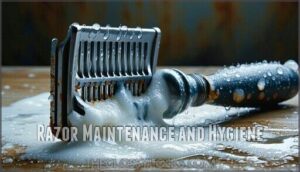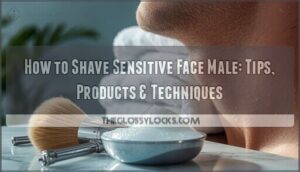This site is supported by our readers. We may earn a commission, at no cost to you, if you purchase through links.

Start by softening your skin with warm water and apply a quality shaving cream or gel. Use a sharp, clean razor with one or two blades, and shave in the direction of hair growth, not against it.
Don’t press too hard or go over the same area repeatedly. Rinse your blade frequently to prevent clogging.
After shaving, pat your skin dry and apply a gentle, fragrance-free moisturizer to soothe and hydrate. The secret lies in proper preparation, gentle technique, and post-shave care that transforms your routine into silk-smooth results.
Table Of Contents
- Key Takeaways
- Pre-Shave Preparation Tips
- Can You Shave Legs Without Razor Burn
- Choosing The Right Shaving Tools
- Shaving Techniques for Smooth Legs
- Preventing Ingrown Hairs and Irritation
- Post-Shave Care for Soothing Skin
- Razor Maintenance and Hygiene
- Common Shaving Mistakes to Avoid
- Achieving Smooth Legs Without Razor Burn
- Frequently Asked Questions (FAQs)
- How do you prevent razor burn when shaving your legs?
- How can I make my legs smooth without razor burn?
- Is it possible to shave without razor burn?
- Do you shave up or down on legs?
- Can You shave legs without razor bumps?
- Should you shave your legs if you have a razor burn?
- Can You shave your legs with a razor?
- Should you use shaving cream to shave your legs?
- What does razor burn look like after shaving?
- What should you not do when shaving your legs?
- Conclusion
Key Takeaways
- Prepare your skin properly – You’ll want to soften your legs with warm water for at least 5 minutes and apply a quality shaving cream or gel to create a protective barrier that prevents razor burn.
- Use the right technique – Always shave in the direction of hair growth with light pressure, and do not go over the same spot multiple times, since this causes irritation and razor burn.
- Choose sharp, clean razors – You should use razors with one or two blades, rather than multi-blade options, and replace your blades every 5-7 shaves to maintain effectiveness and prevent skin damage.
- Practice proper aftercare – Pat your skin dry and immediately apply a fragrance-free moisturizer to soothe and hydrate your freshly shaved legs, which helps prevent irritation and keeps skin smooth.
Pre-Shave Preparation Tips
Proper preparation before shaving your legs substantially reduces razor burn, irritation, and ingrown hairs that can leave your skin bumpy and uncomfortable.
Smooth, irritation-free legs start with proper prep—it’s the difference between silky skin and razor burn disaster.
You’ll achieve smoother results by taking time to dampen your skin with warm water, exfoliate dead skin cells, and shower before picking up your razor, which helps to prevent irritation.
Dampen Skin With Warm Water
You’ll want to dampen your skin with warm water for at least five minutes before shaving.
This water temperature creates the perfect foundation for razor burn prevention by opening pores and providing essential hair softening.
The circulation boost from warm water improves your shaving preparation, making stubborn hairs more manageable.
Here’s what warm water does for your shaving techniques:
- Pore opening allows closer blade contact
- Hair softening reduces resistance during shaving duration
- Enhanced circulation promotes healthier skin response
Exfoliate Before Shaving
Before you pick up that razor, gentle exfoliation sets the stage for your smoothest shave yet.
Using a soft loofah or DIY sugar scrub, work in circular motions to remove dead skin cells that cause razor drag.
This simple skin prep step prevents ingrown hair formation and razor burn.
For sensitive skin, limit exfoliation frequency to twice weekly, choosing gentler scrub types over harsh alternatives.
You can find ingredients for scrubs at online stores.
Shower Before Shaving
After you’ve exfoliated, stepping into a warm shower creates the perfect setup for smooth shaving.
Warm water works like magic – it opens your pores and boosts blood circulation while providing essential skin softening benefits.
The heat benefits are real: your hair becomes up to 60% softer, making your razor glide effortlessly.
Spend 5-10 minutes letting the steam work its magic for optimal results.
Can You Shave Legs Without Razor Burn
Razor burn’s days of ruining your leg-shaving routine are officially numbered.
You can absolutely achieve smooth, irritation-free results with proper shaving techniques and sensitive skin shaving strategies.
Think of your legs as requiring the same gentle care you’d give delicate fabric.
Here are three essential steps for shaving without irritation:
- Soak your legs in warm water for at least five minutes to soften hair and open pores
- Apply thick shaving cream or explore Shaving Cream Alternatives like hair conditioner for sensitive skin
- Use light pressure and take your time—rushing creates those angry red bumps
For Managing Existing Burn, consider Alternative Hair Removal methods during healing periods.
Product Ingredient Analysis shows fragrance-free options work best for reactive skin.
Sensitive Skin Solutions include shaving at night, giving your skin recovery time while you sleep.
These shaving tips transform your routine from painful ordeal into smooth sailing.
Choosing The Right Shaving Tools
Your razor choice makes the difference between silky-smooth legs and irritated skin that screams for mercy.
Your razor is either your skin’s best friend or its worst enemy – choose wisely for legs that thank you.
The right shaving tools transform your routine from painful ordeal into effortless glide.
Here are five essential factors when selecting shaving products:
- Blade Count – Single or double-blade razors work best for sensitive skin
- Razor Type – Weighted handles provide better control and smoother strokes
- Pivoting Head – Flexible heads contour naturally around curves and ankles
- Handle Grip – Non-slip grips prevent accidents during wet shaving sessions
- Shaving Cream – Quality gels create protective barriers between razor blades and skin.
Many prefer cartridge razors for their ease of use.
Shaving Techniques for Smooth Legs
Your shaving technique determines whether you’ll achieve smooth legs or deal with painful razor burn and irritation.
The way you move your razor, the direction you shave, and how many times you go over each area can make the difference between silky skin and red, bumpy legs.
Shave in The Direction of Hair Growth
Finding your hair growth patterns makes all the difference in irritation minimization.
Run your hand gently down your leg to feel which direction hairs naturally lay. This shaving direction offers significant technique effectiveness benefits.
When you follow this natural flow, you’ll experience fewer razor bumps and superior ingrown hair prevention.
Understanding your leg hair patterns can further improve your shaving experience.
Your shaving technique improves dramatically when you work with your body’s design, reducing skin irritation naturally.
Avoid Shaving Against The Grain
Typically, you’ll want to resist the urge to shave upward against your hair’s natural direction. This aggressive shaving direction creates a recipe for disaster, forcing hairs back into follicles and triggering painful ingrown hairs and razor burn.
Technique matters substantially here—minimize irritation by mapping your leg’s unique hair growth patterns first. Then use gentle, smooth strokes that follow the grain downward.
This shaving technique improvement prioritizes ingrown prevention while still delivering satisfactory results. Your skin deserves this gentler approach, and the shaving direction importance can’t be overstated.
For best results, soak legs first in warm water.
Shave Over The Same Spot Only Once
Despite the temptation to perfect that one smooth pass, resist going over the same area multiple times.
Single pass technique with gentle strokes prevents razor burn while respecting your skin sensitivity. Sharp blade sharpness eliminates the need for repeat swipes, making this shaving technique improvement essential for shaving irritation prevention.
Many find success using products for this method. Trust your first glide—your shaving best practices should always minimize irritation through proper shaving technique tips.
Preventing Ingrown Hairs and Irritation
Ingrown hairs and irritation occur when shaved hair curls back into your skin, creating painful bumps and inflammation that can last for days.
You can prevent these issues by following proper shaving techniques, using quality razors, and avoiding common mistakes that damage your skin, which is crucial for preventing irritation.
Avoid Dry Shaving
Imagine this scenario: you’re running late and consider skipping shaving cream. Stop right there! Dry shaving creates unnecessary friction that leads to razor burn and irritation.
Your skin needs proper lubrication to allow the blade to glide smoothly across your legs.
Here’s why hydration importance can’t be ignored:
- Your skin becomes vulnerable to cuts and nicks without protection
- Friction reduction disappears, making every stroke feel like sandpaper
- Skin sensitivity increases dramatically, turning a simple routine into painful punishment
Always use shaving gel—your legs deserve better than these common shaving mistakes.
Use a Razor With One or Two Blades
Sometimes less really is more in the context of blade count.
Single-blade benefits shine brightest for sensitive skin, reducing irritation that multi-blade razors often create.
Each additional blade increases friction and potential razor burn on your legs.
Best razors for smooth results typically feature one or two sharp blades that cut hair cleanly without excessive contact.
These shaving techniques prove gentler than their multi-blade counterparts, making them ideal choices for preventing uncomfortable bumps.
To guarantee a comfortable shave, consider using quality fur shaving cream for added moisture and protection.
Multi-Blade
Irritation
Over-cuts
Don’t Shave Over Cuts or Wounds
When you spot cuts or wounds on your legs, resist the urge to shave over them. This common shaving mistake creates serious problems that’ll set back your smooth-skin goals. Shaving over damaged areas introduces bacteria from your razor directly into open wounds, substantially increasing infection risk while causing delayed healing. The mechanical action of razor blades reopens cuts and disrupts the natural healing process, often leading to scarring potential due to repeated trauma.
Wound sensitivity makes this process unnecessarily painful too. Consider alternative hair-removal methods like trimming around affected areas until healing completes. Focus on preventing skin inflammation management issues by practicing patience with razor burn prevention through proper wound care during your shaving legs routine.
- Skip shaving wounded areas completely until skin heals
- Clean cuts with antiseptic soap before any grooming routine
- Use trimming scissors for hair management around injuries
- Apply healing ointments to promote faster recovery time
- Resume normal shaving only after complete wound closure
Post-Shave Care for Soothing Skin
What you do after shaving matters just as much as your technique, since proper post-shave care prevents irritation and keeps your skin smooth.
You’ll want to focus on moisturizing your freshly shaved legs and maintaining your razor to guarantee the best results for your next shave, which involves maintaining your razor.
Apply Non-Comedogenic Moisturizer
Your freshly shaven legs deserve proper postshave care to prevent razor burn and irritation.
Apply a non-comedogenic moisturizer immediately after patting your skin dry – application timing matters for maximum hydration benefits.
Look for moisturizer ingredients like aloe vera or shea butter that soothe sensitive skin without clogging pores.
Product types such as Bliss Lemon and Sage Body Butter work perfectly for moisturizing legs.
Notably, razor burn develops soon after shaving if precautions aren’t taken.
This body moisturizer creates a protective barrier while your skin moisturizing routine helps repair damage from shaving.
Think of it as your skin’s recovery drink after an intense workout session.
Rinse Razor After Shaving
After moisturizing your legs, your razor deserves attention too.
Rinse it thoroughly under warm water to wash away hair, shaving cream, and skin cells that prevent clogging and reduce bacteria buildup.
This simple step maintains blade effectiveness and prevents razor burn on future shaves.
Rinse frequency matters – clean your razor after every few strokes during shaving legs, then give it a final thorough rinse.
Water temperature should be warm, not scalding.
Proper razor maintenance and razor hygiene prevent common shaving mistakes.
Pro tip: shake excess water off and store upright to prevent rust.
Razor Maintenance and Hygiene
Your razor’s condition directly affects how smooth your shave will be, and a dull or dirty blade can turn your leg-shaving routine into an irritation nightmare.
Proper maintenance, including regular cleaning and timely blade replacement, keeps your razor working effectively and reduces your risk of razor burn, bumps, and infections.
Replace Razor Blades Frequently
Your razor blade’s blade sharpness determines whether you’ll enjoy smooth legs or deal with painful skin irritation.
Razor replacement every five to seven shaves prevents razor burn and maintains ideal razor lifespan. Daily shavers should change blades weekly to avoid common shaving mistakes.
Here’s why frequent razor replacement matters for shaving legs:
- Sharp blades glide effortlessly, reducing irritation and razor burn
- Fresh blades minimize the risk of ingrown hairs
- Regular replacement prevents rust prevention issues and bacterial buildup
Shaving frequency directly impacts when you’ll need new blades.
Store Razor in Cool, Dry Place
Proper storage transforms your razor’s performance and prevents razor burn.
Store your razor blade up in a cool, dry location away from shower steam and humidity. A bathroom cabinet or dedicated drying stand works perfectly for preventing rust and bacteria growth.
This simple razor maintenance tip substantially extends your blade’s lifespan, ensuring consistent shaving results.
Moisture destroys razor blades faster than frequent use, making smart storage essential for effective razor replacement schedules.
Clean Razor Regularly
Maintaining razor blades through proper shaving blade cleaning prevents bacteria buildup and extends your razor’s lifespan. After each shave, rinse thoroughly under hot water to remove hair and debris, then gently tap dry.
An effective routine may also include regular lubrication practices to reduce friction.
Here’s your razor care routine:
- Rinse blades under hot running water after every use
- Prevent bacteria growth by removing trapped soap residue
- Store blade-up in a dry location to avoid rust
- Replace when you notice tugging or increased razor burn
- Use drying techniques that extend lifespan naturally
Common Shaving Mistakes to Avoid
Even experienced shavers make common mistakes that lead to razor burn, bumps, and irritation on their legs.
You can prevent these painful problems by recognizing the most frequent errors, such as shaving against the grain and using dull razor blades for too long.
Shaving Against The Grain
Just like using a worn-out razor can wreck your skin, shaving against the grain creates its own set of problems.
This technique might promise a closer shave, but it dramatically increases irritation severity and razor burn risk.
Your hair density and skin sensitivity determine how badly you’ll react.
Smart shaving techniques for legs always follow hair growth direction.
If you’re seeking irritation-free skin, consider alternative methods like technique modification – work with your hair’s natural pattern, not against it, for smoother results.
Not Replacing Razor Blade Often
That old razor blade sitting in your shower? It’s doing more damage than you realize. Dull blade risks include razor burn, razor bumps, and painful nicks that turn your routine into torture.
Here’s what proper razor replacement timing looks like:
- Replace blades every 5-7 shaves for ideal blade sharpness impact
- Watch for tugging sensations during shaving – that’s your cue
- Consider blade replacement frequency based on hair thickness and density
- Factor razor lifespan factors like storage conditions and usage patterns
Achieving Smooth Legs Without Razor Burn
You can prevent razor burn and achieve smooth legs by making simple adjustments to your shaving routine, including using cooler water temperatures and maintaining proper skin hydration.
These final techniques work together with proper preparation and shaving methods to give you consistently comfortable results without irritation.
Use Cooler Water for Shaving
Hot water feels relaxing, but it’s sabotaging your smooth-leg goals.
Cool water benefits include tighter pores and reduced redness, creating better razor glide while preventing skin irritation.
Think of it as your skin’s best friend – cooler temperatures soothe inflammation and seal moisture for silky results.
This simple switch transforms your shaving routine, offering game-changing protection against razor burn without sacrificing that close, comfortable shave you want.
Exfoliate Regularly for Smooth Skin
Regular skin exfoliation transforms your shaving routine by removing dead cells that trap razors and cause razor burn.
Here’s your exfoliation game plan:
- Choose gentle scrub types like sugar-based products for sensitive skin
- Maintain proper exfoliation frequency – twice weekly prevents ingrown hairs
- Focus on post-exfoliation care with moisturizer to prep legs for shaving
This simple routine delivers exfoliation benefits that keep your skin smooth.
Stay Hydrated for Healthy Skin
Water intake directly impacts your skin’s elasticity and cellular health, creating the foundation for smooth shaving.
Hydrated skin maintains proper turgor pressure, making it more resilient against razor burn during your skin care routine. Lightweight moisturizers with hyaluronic acid can further balance moisture without clogging pores.
| Hydration Level | Skin Condition | Shaving Experience |
|---|---|---|
| Well-hydrated | Plump, elastic | Smooth, burn-free |
| Moderately hydrated | Slightly tight | Minor irritation possible |
| Dehydrated | Rough, flaky | High razor burn risk |
Aim for eight glasses daily – your moisturizing efforts work better when hydration effects start from within.
Frequently Asked Questions (FAQs)
How do you prevent razor burn when shaving your legs?
Like armor protecting delicate skin, proper preparation shields you from razor burn.
Exfoliate first, use warm water, apply quality shaving cream, shave with the grain, use sharp blades, and moisturize afterward.
How can I make my legs smooth without razor burn?
Start with warm water and gentle exfoliation, then use sharp razors with quality shaving cream.
Shave with the grain using light strokes, rinse frequently, and finish with moisturizer for silky-smooth results.
Is it possible to shave without razor burn?
Tired of post-shave irritation ruining your smooth skin goals?
You can absolutely shave without razor burn by using sharp blades, shaving with the grain, proper prep with warm water, and applying quality shaving cream beforehand.
This approach helps to minimize razor burn and ensure a smoother shave.
Do you shave up or down on legs?
You should shave down, following your hair’s natural growth direction. While shaving up gives a closer shave, it increases razor burn and ingrown hair risks substantially for most people.
Can You shave legs without razor bumps?
Razor bumps aren’t inevitable. You can prevent them by exfoliating beforehand, using sharp blades, shaving with the grain, applying moisturizing cream, and avoiding multiple passes over the same area.
Should you shave your legs if you have a razor burn?
Hold off on shaving if you’re dealing with razor burn.
Let your skin heal for a few days first.
Continuing to shave over irritated skin will only make things worse and prolong recovery.
Can You shave your legs with a razor?
Certainly, carefully considering your choice – you can absolutely shave your legs with a razor.
It’s the most common method for smooth legs.
Just use proper technique, sharp blades, and moisturizing products to prevent irritation.
Should you use shaving cream to shave your legs?
Yes, you should definitely use shaving cream on your legs. It creates a protective barrier, helps the razor glide smoothly, and substantially reduces friction that causes razor burn and irritation.
What does razor burn look like after shaving?
Red bumps dot your skin, irritation burns like fire, and tender patches scream for relief.
You’ll notice inflamed follicles, razor burn appears as angry redness, stinging sensations, and sometimes small cuts scattered across freshly shaved areas, which can include razor burn.
What should you not do when shaving your legs?
Don’t dry shave, use dull blades, shave against the grain repeatedly, skip exfoliation, or press too hard.
Avoid going over the same area multiple times—it’s a recipe for irritation and razor burn.
Conclusion
Surprisingly, learning how to shave legs without razor burn isn’t about expensive products or complicated routines.
You’ve discovered that success comes from consistent preparation, proper technique, and gentle aftercare.
By softening your skin with warm water, using sharp razors, shaving with the grain, and moisturizing afterward, you’ll achieve smooth results every time.
Remember to replace blades regularly and avoid rushing through your routine, as these straightforward steps will transform your shaving experience into a comfortable, irritation-free process.
- https://health.clevelandclinic.org/want-a-smooth-safe-shave-every-time-try-these-10-tips
- https://www.webmd.com/skin-problems-and-treatments/remedies-relieve-razor-burn
- https://www.medicalnewstoday.com/articles/razor-burn-on-legs
- https://www.self.com/story/how-to-shave-your-legs
- https://www.today.com/health/skin-beauty/how-to-shave-legs-rcna50711












